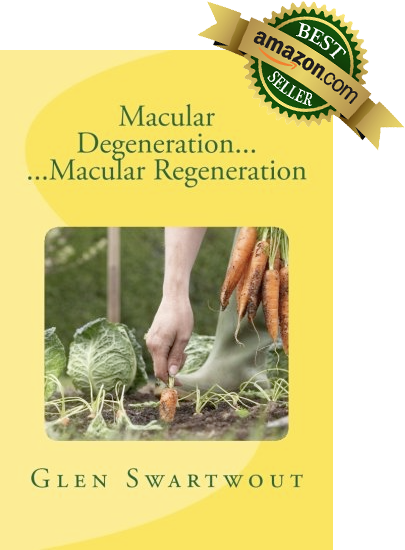Julie Poteet, OD, MS, CNS, FOWNS published
"Is An Ounce of Prevention Worth a Pound of Injections?"
in Review of Presbyopia.
[I'm reprinting it for you here, with additional commentary...]
Research has shown that both optometrists and ophthalmologists frequently fail to diagnose age-related macular degeneration (AMD) about 25% of the time with no difference between the two specialties.1 Histopathological and clinical research suggests that subclinical AMD has both structural and functional consequences before drusen are even evident in clinical imaging.2-5 In fact, drusen represent the tip of the iceberg of the earliest changes caused by AMD. What if practitioners could not only identify those with early AMD by dark adaptation testing before drusen develop but also better identify those most at risk of developing the disease before it begins by macular pigment optical density (MPOD) testing and careful case histories such as family history and lifestyle factors? Educating patients on modifiable lifestyle factors at an earlier stage before drusen appear could change the trajectory of the disease and save sight.
COMMENT: Materialist Medicine misses the mark by focusing on managing damaged structures rather than enhancing corrective functions. Dr. Poteet correctly points to loss of night vision quality as well as functional levels of protective carotenoids in the macula as early indicators of failing macular health. That's why I've develop an arsenal of Functional Formulations targeting these very factors. Night Vision supports restoration and optimization of the dark adaptation function, which eye doctors can easily measure. The carotenoids are critically important for maintenance of vision and many other functions with healthy aging. Professor Ames of Stanford University considers the "Longevity Vitamins" because they are essential to prevent blindness and other degenerative conditions, even though they are not conventionally classified as vitamins since there is no acute deficiency disease. Professor Ames is widely known for developing the standard Ames test for the carcinogenicity of toxins... One of the challenges with carotenoids is that they compete for absorption by a single absorption channel in the small intestine. When multiple "mixed carotenoids" are supplemented, as they often are, there is competitive inhibition of their bioavailability, and if alpha or beta carotene is included in the mix, none of the others may be effectively absorbed. That's why I formulate Macular Wellness and other relevant formulations with a single carotenoid in each to ensure absorption. I also use a series of botanical and nutritional synergists to increase solubility, bioavailability, local circulation, absorption, and delivery to the eye and other target tissues. We also exercise maximum care to avoid use of interfering factors present in most commercial products, including stearates (which form a biofilm on nutrients and the intestinal mucosa, reducing absorption of all nutrients including those in the diet), phthalates (which destroy immune function), and gelatin (which harbors glyphosate according the the research of MIT's Professor Stephanie Seneff). Combining multiple synergists has become a core principle in creating Functional Formulations. Even if pairs of synergistic effects produce only an average of 10% increase in effectiveness, combining dozens of such pairs can multiply to achieve a geometric increase in outcomes of hundreds of percentage points. We liken this to the clinical effectiveness and efficiency achieved by Dr. Reckeweg with complex homeopathy, and the widely acknowledged entourage effect seen in botanical medicine. We also promote the addition of other synergistic therapies including therapeutic PEMF frequencies that increase circulation by 30%, an amount typically lost in 40 years of aging. A second foundational therapeutic addition is high pH water that is also enriched in electron content. The smaller clusters of this 'Living Water' penetrate tissues and cells 10 times better than other filtered waters, delivering increased nutrition and detoxification. Combining these two therapies yields a combined increase of 1300% effect. Each of these modalities alone is powerful enough to prevent the need for a scheduled limb amputation, while no other therapy is known to deliver such healing power.
When we transform our orientation to optimizing function we can achieve much more than merely preventing disease. We come to realize that disease and health are not a binary condition dependent upon a diagnosis, but a continuum of states in which the middle ground is a state of susceptibility. The family history is considered as a risk factor for AMD as with many chronic, degenerative, and all-too-common conditions. When our goal is transformed from diagnosing and treating disease to optimizing wellness, we discover that the inherited pattern of susceptibility to maladies that run in the family is an epigenetic state that cries out for healing at the earliest possible point. It is a once-in-a-lifetime non-invasive process of Transgenerational Perception Reframing that can be accomplished via the internet with a modicum of hardware, software, and coaching support. Typical Odds Ratios for risk based on family history of a condition can be over 2 with a single first degree relative and over 4 with multiple first degree relatives affected. It's important to realize that even 100% 'genetic' conditions are epigenetically modifiable. For example, two identical twins shared the genes for Retinitis Pigmentosa. One went blind when she reached adulthood while her sister never lost the normal visual function that is characteristic in childhood in those with the genes for RP. We now have powerful tools such as EVOX and NES Infoceuticals to turn off disease genes and activate healthy genes.
Source: Family health history: underused for actionable risk assessment https://ncbi.nlm.nih.gov/pmc/articles/PMC6822265/
In an article for Women in Optometry, Professor of Optometry Dr. Julie Rodman makes a clear case for earlier identification of macular degeneration through dark adaptation testing. In her article, “Big Change Is a Small Choice,” Professor Rodman points out that trouble seeing at night is a symptom that appears before the onset of drusen, and impaired dark adaptation is an early symptom. Waiting until drusen appears is a broken system as so many people continue to go blind from the disease. “It’s broken, so let’s fix it…by detecting AMD before clinical signs are evident on examination and managing early and intermediate stage disease with the same close attention that retina specialists focus on late-stage disease, we potentially can make a significant difference in patients’ lives.”
[see original article for images]
Optomap and OCT of both eyes from a 78-year-old female with intermediate to advanced dry AMD. This patient is on an AREDS2 supplement with fatty fish consumption twice a week and a Mediterranean diet. She has been advised of evidence-based lifestyle interventions to help reduce the risk of disease progression.
COMMENT: An 86 year old man lost his driver’s license despite taking a top Macular health supplement from Life Extension Foundation, a great organization that does tremendous education and important lobbying to keep supplements available to all of us. In one month of Accelerated Self Healing, he regained enough vision to restore his driver's license. One out of three Americans over the age of 75 suffer from Macular Degeneration (AMD) and it is the leading cause of blindness. Even after 40 years of clinical research documenting that it can heal at any stage, the textbooks and standard practices still call it irreversible, because it is irreversible with the current standards of care. This is why I put so much effort into developing the New Medicine with a strong foundation in Clinical Theory and Clinical Praxis.
Discuss Prevention Strategies
Eye doctors can learn a lot about prevention from the American Heart Association. When heart experts talk about prevention, they usually refer to one of three types: secondary, primary, and primordial prevention.6,7
Secondary prevention:
These efforts are started after someone has already had a heart attack or stroke, undergoes bypass surgery, or develops some other form of heart disease in an attempt to prevent a second heart attack or stroke.
Primary prevention:
This type of intervention aims to keep an individual at risk of heart disease due to risk factors such as high blood pressure or high cholesterol from having a first heart attack or stroke. The appearance though of worrisome cardiovascular risk factors means that inflammation, atherosclerosis, and/or endothelial dysfunction are already at work.6
Primordial prevention:
The word “primordial” means existing from the beginning, and this type of prevention involves working to prevent inflammation, atherosclerosis, and endothelial dysfunction from taking hold in the first place. Once rarely discussed, primordial prevention is now the cornerstone of the American Heart Association’s definition of ideal heart health and efforts to help people achieve it.6 As its name applies, the sooner you can start practicing primordial prevention, ideally from childhood on, the likely you are to achieve it and protect yourself from heart disease.6, 7
If we take these prevention terms and apply them to irreversible vision loss from the most common cause of blindness in individuals over 50 in the developed world, advanced macular degeneration, it may look something such as the following:
Secondary prevention would apply to the sight-saving injections for late-stage AMD that retinal surgeons use to stave off further vision loss once the advanced stage has occurred.
COMMENT: According to leading holistic Ophthalmologist, Dr. Ed Kondrot, 40% of those receiving injections end up with worse vision in the end than they would have without the procedures. Clinical research results are distorted by defining stable vision as losing up to 2 lines of visual acuity! Some patients, such as one of our clients, end up losing all vision in the injected eye due to infection caused by the breach of the ocular integrity. Our clients with Wet AMD typically are able to reduce the frequency of prescribed injections and eventually not need them anymore. Just last week a client reported that her Retinologist was shocked that she didn't need an injection because she had converted from Wet to Dry AMD. We also support the healing of problematic leaky neovascular blood vessels with our botanical/nutritional AngiogenX capsule formulation. The reduction of scar tissue that tends to contract and cause vessel leakage and breakage is supported by a Functional Formulation as well, called Clear the Way. Visible reduction in scar tissue is often achieved even in the first week. We look forward to the application of this formula with hidden scar tissue such as in head trauma, where contraction of the scar tissue 6 to 12 months following closed head trauma is a common cause of visual sequellae rehabilitated by neuro-optometrists with behavioural vision therapy. Together, we will be able to achieve greater restoration of function with faster and easier results!
[see original article for images]
Optomap from 78-year-old patient’s 57-year-old son with no macular drusen and no night driving complaints. Because of his family history of macular degeneration, in-office MPOD testing was performed, and his score was 0.20, which is very low and falls into the category of grossly inadequate photoreceptor protection. This patient was put on a macular carotenoid supplement and advised on lifestyle prevention measures to reduce his risk of AMD.
Primary prevention could apply to the use of AREDS2 supplements for intermediate or late AMD where the formation of drusen has already occurred. Research shows that RPE cells deposit locally generated cholesterol beneath the RPE cell layer and in Bruch’s membrane before drusen are formed.2,5 With disease progression, this cholesterol continues to accumulate, resulting in focal areas that are thickened enough to be identified as drusen.2,3,4,5 This cholesterol accumulation causes three primary insults to the retina: inflammation, oxidative stress, and disruption of oxygen and nutrition supplies to the outer retina.3,5 Waiting until intermediate AMD to intervene with AREDS2 supplements means that inflammation and oxidative stress have been occurring for some time.
In his opinion as stated in an article he wrote on how early diagnosis can improve AMD outcomes, Dr. Jeffry Gerson, who lectures and writes extensively on AMD, stated the following, “The clinical staging of AMD is misinterpreted and has led to a defeatist view of what we can achieve in terms of more effective management of dry AMD. By the time we can visualize change, damage has already been done.” 5
Primordial prevention could include public health interventions with the aim to adopt a correct lifestyle, including healthy diet, physical activity, and cessation of smoking as recommended strategies for AMD prevention. Educating patients with a family history of macular degeneration on prevention strategies should occur with every eye examination.
Nutrients and Food Sources for AMD Prevention9
Nutrients
Vitamin C
Food Source
Citrus fruits and juices, green peppers, broccoli, potatoes
COMMENT: Remedies
Vitamin C Syntropy - the Complete Intracellular Antioxidant System
Vitamin E
Whole grains, eggs, nuts, collard greens, spinach
Vitamin E Spectrum: the undiluted whole Vitamin E complex
Beta carotene
Carrots, kale, spinach
[Avoid combining Alpha, Beta and Mixed Carotenoids with key therapeutic carotenoids to avoid suppressing absorption by competitive inhibition]
Zinc
Meat, poultry, fish, whole grains, oysters, nuts, eggs
Zinc Taste Test to assess and monitor deficiency; Zinc Syntropy when focused repletion of Zinc deficiency is called for.
Lutein and zeaxanthin
Spinach, kale, egg yolk, parsley, other green leafy vegetables
Macular Wellness Lutein, and Zeaxanthin, as well as five other Macular Wellness formulations, each with a single carotenoid: Meso-Zeaxanthin, Lycopene (the one found deficient in the blood of those developing AMD), Astaxanthin, Safranal, and Crocin. Safranal & Crocin are found in Saffron which is shown to improve visual acuity.
Omega-3 (DHA and EPA)
Fish and seafood, nuts and seeds, fortified foods
WholOmega from whole algae oil supplying DHA, Phytoceramides, added Vitamins A, C, E, polyphenol C3G, and Saffron, shown to increase visual acuity
COMMENT:
Our core remedies for Dry AMD include:
- • 7 Macular Wellness Formulas, each with a different standardized carotenoid to ensure absorption, along with 8 coenzymes, Magnesium, 5 Amines, Lipoate, 8 Phenols, Ginsenosides, and 10 additional ingredients to increase bioavailability, absorption and delivery to eye, brain, and body tissues. People often rotate several of the carotenoids with different meals based on Biofield Analysis. That means we recommend they take the specific remedies that increase the electrophysiological coherence in the body field at that time. Remedy programs are ideally adjusted monthly to support restoration of lost function.
- • 2 Drusen Dissolve Formulas, one with a meal, and the other between meals.
- • WholOmega, typically 4 capsules daily with the heaviest meal.
Core recommended therapies in AMD as with any other degenerative health challenge include:
- • State of the art PEMF Frequencies up to 20,000 Hz (the same range as hearing), and
- • Living Water (a technology developed in Japan and widely prescribed there, which has a high pH, low ORP, and small water clusters that penetrate the tissues and cells ten times better than other waters carrying nutrition and cleansing as well as physiologically available energy as described by the Nernst equation for energy in a fluid medium).
These two therapies combined further increase delivery of the Functional Formulations to the cells and tissues by 1300%. Together with Accelerated Self Healing support for all of the body's active self healing processes, these processes reverse a year of aging and degeneration throughout the eyes, brain, and body in each month of the full program. Indicative of their restorative healing powers, each of these therapies independently are the only two ways to save a limb that has turned black with gangrene and is scheduled for amputation.
Wet AMD is more advanced, and more complex, so it requires additional core remedies including:
- • Clear the Way to reduce scar tissue, which contracts, restricting the flow of circulation, nerve current and direct current meridian energy as well as contributing to leakage and breakage of blood vessels.
- • Careful consideration and administration of AngiogenX to reduce angioneogenesis which produces neovascularization by leaky blood vessels
Both of these formulations are to be avoided when there is active wound healing such as following trauma or the controlled damage of a surgical procedure. Cicatrization in the acute stages of wound closure requires the processes that these formulations are designed to reverse.
Are Leafy Greens the New Carrots of Healthy Vision?
Carrots have long been considered the go-to vegetable for healthy vision. Rich in beta carotene that is converted to vitamin A and needed to form rhodopsin, carrots provide vital nutrients for the retina. However, the association between carrots and eyesight originated from a myth. During World War II, British Royal Air Force pilots began using radar to target and shoot down enemy planes. In an effort to keep this new technology a secret, the visual accuracy of the pilots, especially at night, was attributed to eating carrots. This led to a longstanding campaign that promoted carrots for better eyesight. Based on emerging research on the benefits of the dietary carotenoids lutein, zeaxanthin, and meso-zeaxanthin, a more accurate public health campaign today would promote leafy greens for healthy vision.
COMMENT: The true source of increased night vision in WWII pilots was the Anthocyanidins in Bilberry pie, noted after it was served for desert at dinner before a night sortie. While the leafy crucifers, Kale and Collards, are rated the highest nutritional value of all common foods, many clients find it challenging to source and eat them in organic quality on a regular basis. I've formulated a powdered Crucifer Complex to supplement when the fresh produce is lacking in the diet.
Studies such as The Blue Mountains Eye Study show a greatly reduced risk of developing drusen or AMD with higher amounts of lutein and zeaxanthin in the diet.10,11,12 A study by Huang et al. showed that participants with high levels of serum lutein and zeaxanthin had a 79% reduced risk of developing AMD in comparison to subjects with lower serum concentration.13 It has been shown that in the aging retina, the inhibition of the endogenous antioxidant capacity, marked by the depletion of macular carotenoids lutein, zeaxanthin, and meso-zeaxanthin, is a major contributing factor in the progression of AMD.14 Thus, discussing the addition of more leafy greens in the diet for better eye health is justified on every patient.
Interestingly, higher macular pigment scores are not only applicable to the prevention of macular degeneration. In a recent study from the National Institutes of Health, researchers showed that macular pigment density may indicate a new risk factor for glaucoma.15 The researchers observed a positive association between MPOD and central subfield GCC thickness 15 years later. MPOD was positively associated with peripapillary RNFL superior and temporal quadrant thickness among eyes with primary open angle glaucoma. Their results linked low MPOD to retinal layers that are structural indicators of early glaucoma.15
COMMENT: We include individual carotenoid support in our various glaucoma related functional formulations, including Neuroprotect, OcuFlow Daytime, and OcuFlow Bedtime...
Sum of the Parts: Lifestyle Factors Beyond Leafy Greens
A single nutrient or food approach is not able to reach the synergistic effects of food and nutrients consumed in combination in the diet, therefore overall dietary patterns have been studied. A reduced risk of all types of AMD has been shown with a Mediterranean Diet.16,17 Along with diet, other factors such as smoking cessation, regular physical activity, reducing excessive body weight and avoiding obesity, and sleeping seven to eight hours per night have all been associated with a decreased risk of developing AMD.8 Concerning body mass index (BMI), it is important to stress that studies have shown that excess body fat can alter the transport and deposition of carotenoids from blood to the macula, leading to a reduction of macular pigment levels in the fovea.8,18 Excess body weight and obesity are associated with a higher risk of developing AMD, and it has been demonstrated that people affected by obesity have a major risk to manifest late AMD in comparison to subjects with a normal weight.8,19
COMMENT: As with many other diseases of modern culture, AMD is still unknown in those remaining areas of the world without access to any refined or processed foods. We suffer fundamentally from Nature Deficiency, and at the same time we are exposed to massive degrees of stress and toxicity. EMF exposure today, for example, is a quadrillion times greater than a mere decade ago, and it causes iontophoresis of heavy metals in the body, as well as a 10,000% increase in production of defensive toxins by moulds and fungi in the environment. Causality of disease is multifactorial and true healing requires support at the causal level. Fortunately it can be simplified while enhancing outcomes by working with the intelligent healing responses of the Minding Body, the Body-Mind-Spirit complex, which prioritizes and sequences the healing efforts. Like the mind, the capacity for effective multitasking is limited. Supporting active healing processes to rapid completion allows for rejuvenation and regeneration of lost and damaged functions and tissues, including vision in blinding eye diseases including AMD at all stages. Likewise, in Glaucoma we are seeing clients who are able to restore more than half of their lost visual fields in several months of Accelerated Self Healing...
We as a profession can no longer ignore the science of prevention for not only macular degeneration but also other blinding eye diseases such as glaucoma. Minding the macular pigment through addressing the importance of green leafy vegetables in our diets as well as overall eating patterns has been shown to be preventative for one of the most blinding eye diseases on the planet. Public health campaigns successfully create awareness and help evoke change. Our current health care system of waiting until disease is apparent before intervening is broken and not sustainable. Because of our imaging technologies, we as a profession are perfectly poised to be on the forefront of prevention. Let’s hope in 2024 there exists a greater awareness amongst doctors and patients alike of the power of nutrition and lifestyle to mitigate the risk and course of disease.
References
1 Owsley C, McGwin G, Clark M, et al. Delayed rod-mediated dark adaptation is a functional biomarker for incident early age-related macular degeneration. Ophthalmology, October 30, 2015.
2 Pikuleva I, Curcio C. Cholesterol in the retina: the best is yet to come. Progress in Retinal and Eye Research. 2014 July:41;64-89.
3 Owsley C, McGwin G, Jackson G, et al. Effect of short-term, high-dose retinol on dark adaptation in aging and early age-related maculopathy. Invest Ophthalmol Vis Sci. 2006:47(4);1310-8.
4 Owsley C, Jackson G, White M, et al. Delays in rod-mediated dark adaptation in early age-related maculopathy. Ophthalmology. 2001;108(7):1196-202.
5 Gerson J. How early diagnosis can improve AMD outcomes. Review of Optometry. September 15, 2017.
6 Lloyd-Jones DM, Hong Y, Labarthe D, et al. Defining and setting national goals for cardiovascular health promotion and disease reduction: the American Heart Association’s strategic Impact Goal through 2020 and beyond. Circulation, 2010;121:586-613.
7 Harvard T.H. Chan School of Public Health. The Nutrition Source. Preventing Heart Disease.harvard.edu
8 DiCarlo E, Augustin A. Prevention of the onset of age-related macular degeneration. Clin. Med. 2021, 10, 3297.
9 Van Leeuwen R, Boekhoorn S, Vingerling JR, et al. Dietary intake of antioxidants and risk of age-related macular degeneration. JAMA 2005, 294, 3101-3107.
10 Tan JSL, Wang JJ, Flood V, et al. Dietary fatty acids and the 10-year incidence of age-related macular degeneration: The Blue Mountains Eye Study. Arch Ophthalmol. 2009, 127, 656-665.
11 Walchuk C, Suh M. Nutrition and the aging retina: A comprehensive review of the relationship between nutrients and their role in age-related macular degeneration and retina disease prevention. Food Nutr. Res. 2020, 93,293-332.
12 Delcourt C, Carriere L, Delage M, et al. POLA Study Group Plasma lutein and zeaxanthin and other carotenoids as modifiable risk factors for age-related maculopathy and cataract: The POLA Study. Ophthmaol. Vis. Sci. 2006, 47, 2329-2335.
13 Huang LL, Coleman HR, Kim J et al. Oral supplementation of lutein/zeaxanthin and omega-3 long chain polyunsaturated fatty acids in persons aged 60 years and older, with or without AMD. Ophthmaol. Vis. Sci.2008, 49, 3864-3869.
14 Lem DW, Gierhart DL, Davey PG. A systematic review of carotenoids in the management of diabetic retinopathy. 2021 Jul; 13(7):2441.
15 Lawler T, Mares JA, Liu Z et al. Carotenoids in age-related eye disease study investigators. “Association of macular pigment optical density with retinal layer thickness in eyes with and without manifest primary open-angle glaucoma.” October 6, 2023 BMJ Open Ophthalmology.
16 Merle BM, Colijn JM, Cougnard-Gregoire A, et al. EYE-RISK Consortium. Mediterranean Diet and Incidence of Advanced Age-Related Macular Degeneration: The EYE-RISK Consortium. Ophthalmology. 2019;126:381-390.
17 Nunes S, Alves D, Barreto P et al. Adherence to a Mediterranean diet and its association with age-related macular degeneration. The Coimbra Eye Study report 4. Nutrition 2018:51:6-12.
18 Bovier ER, Lewis RD, Hammond BR. The relationship between lutein and zeaxanthin status and body fat. Nutrients, 2013;5:750-757.
19 Zhang QY, Tie LJ, Wu SS et al. Overweight, obesity, and risk of age-related macular degeneration. Ophthalmol. Vis. Sci. 2016;57:1276-1283.
COMMENT: I am very grateful to Dr. Poteet for the fine work she is doing in educating the profession about the power of nutrition in prevention of blinding eye diseases. I look forward to collaborating with her and the Ocular Wellness and Nutrition Society as we prepare to launch the public release of the first of our 150+ Functional Formulations that have been in research for 40 years and active development over the past decade.
World-Class Coach & Trainer, David Wygant, the real life inspiration for the Movie "Hitch" has agreed to share his experiences with healing dry macular degeneration as he begins his journey with Accelerated Self Healing™.
David takes tremendous care of his health, and has already worked with many top practitioners in the field, so let's see if we can find a way to make a breakthrough with him on his quest to reverse the early stages of ARMD.
Watch for future updates as David makes progress on his quest for healing...
Update: At his first eye exam after beginning our program, David's eye doctor reported that his vision has improved and the drusen deposits underneath his retina are already decreasing...
Learn How You Can Heal Yourself Without Leaving Home

The regular medical doctors don't have an answer. This book gives you so many answers for those searching to save their eyesight.
Jag


"Mr. DeCosta has had dramatic improvement in his vision despite having had wet macular degeneration... He gave me a copy of the report that you had written on this topic, and I appreciate all of the work that you did..."
Bruce Ballon, M.D., Harvard trained Retinologist

"I'm really seeing some encouraging results with actual healing of tissue... Seeing documented recovery of some visual fields and also seeing assistance with lens clarity improving nicely and overall just general health improvement. And so, it's been a great, great addition to my practice..."
Dr. Todd Wylie, Doctor of Optometry
© Copyclaim 2023
Remedy Match LLC, DBA Healing Oasis
[email protected]
PO Box 126 Hilo, Hawai'i-Kingdom [96721]
+1 (808) 217-9647
[*"The statements herein have not been evaluated by the Food and Drug Administration. This is not intended to diagnose, treat, cure, or prevent any disease."] T.D.C.
